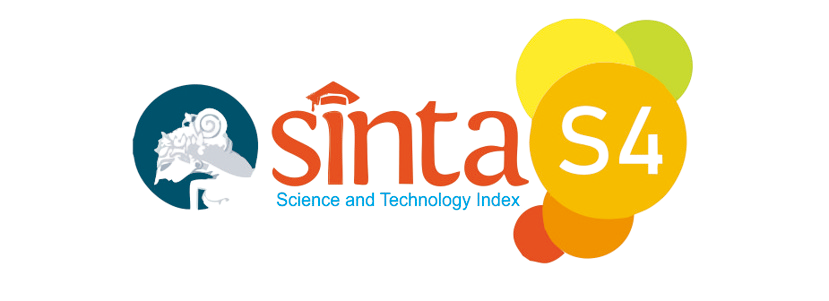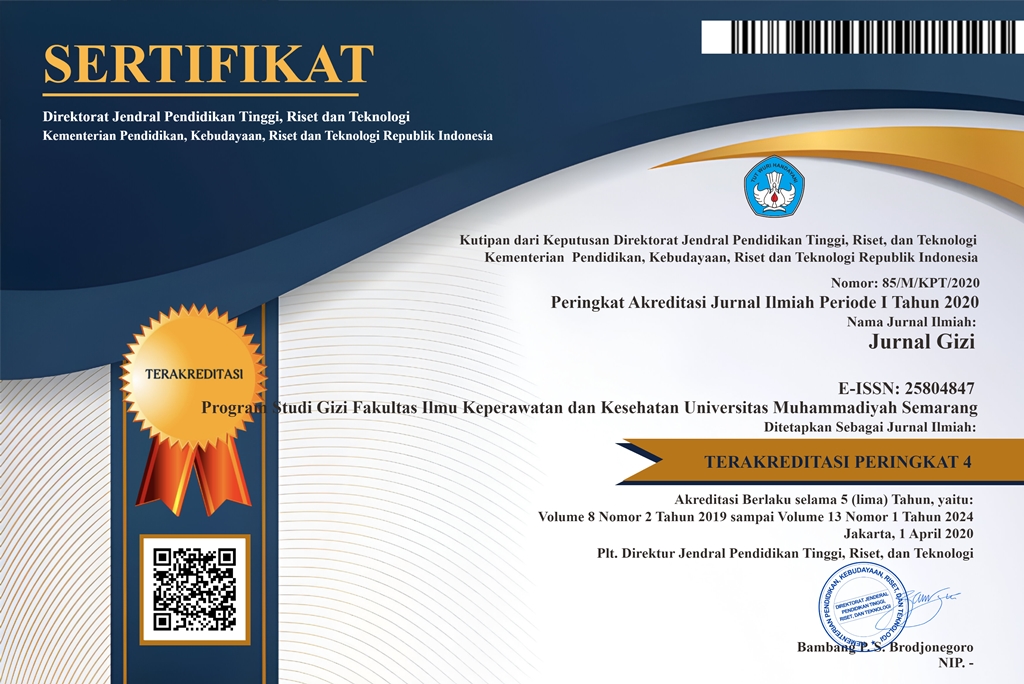Perbedaan Konsumsi Cairan, Serat Makanan dan Aktivitas Fisik Berdasarkan Proses Defekasi pada Mahasiswa Diploma III Gizi Universitas Muhammadiyah Semarang
(1)
(2)
(3)
(*) Corresponding Author
Abstract
Water consumption and dietary fiber in sufficient quantities every day can help to expedite the process of defecation, there by preventing or reducing hemorrhoids and constipation. Physical activity can also help smooth the process of defecation by stimulating peristalsis which facilitates the movement of chyme along the colon. Lifestyle changes that occur in the community, especially in adolescents who like to consume fast food thats high-calorie, and low consumption of fiber and water causes various diseases such as constipation. This study aims to prove the difference of fluid intake, dietary fiber, and physical activity based on the process of defecation on student Diploma III Nutrition, University of Muhammadiyah Semarang.
The study design is cross-sectional study with subjects students Diploma III of Nutrition, University of Muhammadiyah Semarang. Data were collected by interview and recall method for fluid consumption, dietary fiber, physical activity, and the process of defecation. Statistical analysis using the Mann Whitney test to determine differences in fluid intake, dietary fiber, and
physical activity based on the process of defecation.
Based on the statistical test Mann Whitney p = 0.000 there was significant discrepancy between fluid intake , dietary fiber based on the process of defecation and consistency of stool as well p = 0.010 there was significant difference between physical activity based on the process of defecation and consistency of stool.
The Conclusions is consumption of fluid, fiber food and physical activity sufficient in an amount can make easy the process of defecation rather than fluid intake, dietary fiber, and low
physical activity.
Keywords: Fluid Consumption, Dietary Fiber, Physical Activity, defecation process.
The study design is cross-sectional study with subjects students Diploma III of Nutrition, University of Muhammadiyah Semarang. Data were collected by interview and recall method for fluid consumption, dietary fiber, physical activity, and the process of defecation. Statistical analysis using the Mann Whitney test to determine differences in fluid intake, dietary fiber, and
physical activity based on the process of defecation.
Based on the statistical test Mann Whitney p = 0.000 there was significant discrepancy between fluid intake , dietary fiber based on the process of defecation and consistency of stool as well p = 0.010 there was significant difference between physical activity based on the process of defecation and consistency of stool.
The Conclusions is consumption of fluid, fiber food and physical activity sufficient in an amount can make easy the process of defecation rather than fluid intake, dietary fiber, and low
physical activity.
Keywords: Fluid Consumption, Dietary Fiber, Physical Activity, defecation process.
Full Text:
PDFArticle Metrics
Abstract view : 1636 timesPDF - 744 times
DOI: https://doi.org/10.26714/jg.5.2.2016.%25p
Refbacks
- There are currently no refbacks.
Diterbitkan oleh: Program Studi Gizi (D3 dan S1)
Fakultas Ilmu Keperawatan dan Kesehatan
Universitas Muhammadiyah Semarang
Sekretariat: Jl. Kedungmundu Raya No. 18 Semarang
Contact Person : Hapsari Sulistya Kusuma, S.Gz, M.Si (+62 85 6 41 536 553)

This work is licensed under a Creative Commons Attribution 4.0 International License.









.png)
.png)